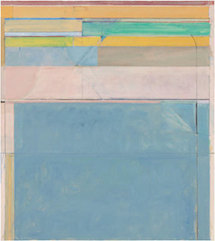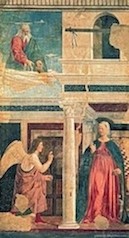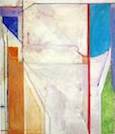
Royal Academy of Arts, London
14th March – 7th June 2015
This is a unique opportunity to view a survey of the paintings of the American artist Richard Diebenkorn. His work has not been seen in this country since the exhibition at the Whitechapel Art Gallery in 1992 and there are no paintings in public or private collections over here.
In relation to this show there is a particularly interesting article on the RA website written by artist Ian McKeever in which he talks about the way some painting invokes a sense of stillness. He says ‘For the painting to hold the light, as opposed to depicting it by the means of chiaroscuro and shading, would seem to be what Diebenkorn is aiming for. A state in which the space in the painting is self-illuminating, almost transcendent. Such omnipresent light takes us back to Italian Duecento and Trecento painting, to a light before the slant of the shadow and human tainting. A time when form was in pure colour’. Here is a link to that article where the two pictures below can be seen in a larger format:
https://www.royalacademy.org.uk/article/ian-mckeever-on-richard-diebenkorn


Richard Diebenkorn “Ocean Park No 116”, 1979
and Pierro della Francesca, “Legend of the True Cross: Annunciation” c.1452
I include here an adaptation of the comment I left on the RA website in response to Ian McKeever’s essay:
We have much to be grateful for in the work of Richard Diebenkorn, especially those later Ocean Park paintings. There are so many things one could say, and yet it is true that in the end it is about a silent confrontation. Yes indeed the work calls for us to be still, for it is only in so far as we can approach that stillness that the states of materiality before us (light, air, fluidity, solidity), and the passage from one to another, can be truly witnessed and felt, just as when we stand alone in front of a landscape, or closer still, in front of our own being.
Today, one seems to have to talk in hushed tones when mentioning ‘depth of feeling’ or ‘spirituality’ in relation to painting, and yet one cannot fail to be touched by these paintings in some inexplicable way, if one is open to them. I never met Diebenkorn, yet I can honestly say that he taught me how to paint. I more fully understand his paintings through the experience of being in movement, in the process, inside the question when engaged in the act of painting. I cannot assume I know what integrity means at the outset – it isn’t a given, I have to search for it. If the large Ocean Park paintings remind us more of the external landscape, the smaller works on paper seem to become more suggestive, to me, of a more interior world – more intimate, poetic, expressing something about mortality on the one hand and on the other, something jewel like – the possibility of eternal life perhaps. They seem to connect with something way back – the Byzantine, the Egyptian. There are some of us that see much of painting today as being bereft of something vital and are searching through our work to keep that something alive. That something in Diebenkorn’s work is palpable.

Richard Diebenkorn, Ocean Park No 43 1971
Ashley West
See also
http://www.in-between.org.uk/arts-and-crafts/the-work-of-richard-diebenkorn/
http://www.in-between.org.uk/arts-and-crafts/discovering-black-club/
http://abstractcritical.com/article/richard-diebenkorn-a-door-opened/index.htm l